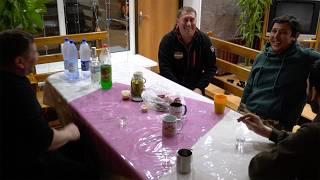
Climbing pro made from knots??? Textile passive protection tested!
Комментарии:

Drop Tower Episode!!!
Ответить
Real rock tests yes please. Not actually sure what that video proved because how often do you come across such a bomber placement with a perfect v in the rock going from 2 inch to 1/4 inch like that?
Ответить
Yoo that would be sick
Ответить
I want to see these in real rock
Ответить
It would be great to see it tested in a drop test since compression and deformation of the knot may require time to compress.
Ответить
definitely wanna see in real rock
Ответить
It would be very interresting to see on real rock !
Ответить
Yeah would love to see some whips on real rock.. would be so fun! Maybe you can even recruit Jenny😍
Ответить
make 2 plates with slabs of granite or something for that machine. You can probably get them custom from some place that makes grave stones
Ответить
Dudes the jaws are opening during the last moments. It squeezes the knot flat and then increases the crack size. No shit they slip
Ответить
the reason you arent getting as consistent results with you crack plates as the nuts is because there is no friction. the knot does a much better job of prying it open since not as much longitudinal in line force is being resisted at the plate interface. Your tension in your bolts is very large and there is some deformation. Stiffer bolts (high strength or larger diam) would help. It also looks like there is some bending in the plate that opens the gap.
in all, only a few knots pulled through, so the large scale behavior was met regardless.

Pulling that material on slick metal is like sliding on a wet slip n slide, definitely think rock would be twice as good but would be worth testing
Ответить
How can they skip the monkey's fist?
Ответить
I love these results! I would love to see the surviving knots pulled to breaking (just pulled straight). Why do I want to see that? No good reason. I'm just curious how much those knots have left in them after being squeezed through the constriction.
Ответить
Love this! I love the conventional stuff, but these obscure gear tests are such a nice bonus. I have always wondered about these and other odd pieces of gear like the beal escape and I loved the video on that too. Please test these in real rock!
Ответить
Those are not real button knots are they? They are the easier style of button knots from what I can see.... Am I right?
Ответить
Did you go out and do that out in real life test?
Ответить
Real rock!!!
Ответить
I did that in the day. It's depicted in Royal Robbins' Basic Rockcraft, so I tried it with many regular pieces for back up. It worked. In those days you never expected that a helicopter was going to come and rescue you. Nor was some gym employee telling you that this is a "safe" sport so we learned everything we could since knowledge weighs nothing and could, at the least, save you from the embarrassment of having skilled people have to rescue you due to your ineptitude.
Ответить
I would love to see an update to this video with the drop tower!
Ответить
I fell already few times on stuff like that.
We climb in Saxony, Germany only with textile.
The biggest problem is the stability of the rock, you can never know.

What about trying these in the newer rock simulation you got to test cams?
Ответить
infinite real rock testing is what we want
Ответить
You need a spreader bar in your holder, as the knot pulls even with the bolts, the back of the holder narrows and the front widens and let's the knot thru. 🤓👉
Ответить
Wow!
Ответить
I would maybe trust these if I preset them so like 4 or 5 kn
Ответить
Real rock pls!
Ответить
Have you tried adding a layer of course sandpaper to the inside of the metal clamps to add friction?
Ответить
do more tests! definitely curious seeing how these behave in real rock
Ответить
yes real rock
Ответить
I wish I had found your channel a year ago! Thanks
Ответить
I would be curious if you could place rubber inside some of the knots or tape the outside of the knots to decrease the squishing of the rope or increase the integrity of the rope itself.
Ответить
I think friction is the biggest factor in these rope 'knuts', would love to se a video of these tested on real rock like your cam video
Ответить
I wonder if you stuck some sand paper on those metal plates to replicate rock surface would help or just rip the rope up and make it worse
Ответить
Id like to see the law maker testing these things out for real.
Ответить
It's been so long. We need that real rock test.
Ответить
That is just spooky
Ответить
Im all here for it, im from saxony and live right by the saxon sandstone terretories, my trad history is basicly all about soft pro, i started with simple knoted slings and am now using ufos. Ive never whiped on either since i mostly do easy stuff up to 5.8 where im not really in danger of faling, but i do want to try harder stuff where i need to trust my gear. Id love a real rock one, especially with ufos. I would be willing to send you a ufo incase there is no supplier in north america.. how many would be enought for a solid test?
Ответить
I would like to see it placed in rock
Ответить
I'd just duct tape my rope to the rock. Duct tape fixes everything!
Ответить
please do a followup on real rock ❤
Ответить
Czech sandstone climbing is weird in so many ways. Apparently there used to be a ton of routes where the first hold of a pitch required standing on your belay's shoulders or building a human pyramid for more extreme ones
Ответить
You should rough up those plates. It would simulate the surface of a rock better
Ответить
I usually dont thighten the figureight that much. Therefor it lays pretty flat. As the pull and friction start working their magic, the knot bundles up relativly wide.
Ответить
HOW ABOUT HEMP ROPE ? Maybe it would deform less ?
Ответить
These tests are nonsense. You can clearly see how the metal plates move backwards during loading and thus enlarge the opening at the front. In addition, the friction of the metal plates cannot be compared with that in sandstone
Ответить
Seems like a half step safer than free soloing. Probably fine for bodyweight, but I'm not sure I would want to fall on it.
Ответить
Friction is the key. These tests are pointless without considering it. Sandstone is much softer than metal friends or nuts. Therefore, using soft knots reduces abrasion. In this type of sandstone, knots hold better than metal cams because they create more surface friction and "bite" into the rock. The leader's rope is less likely to dislodge them compared to a nut.
Ответить










